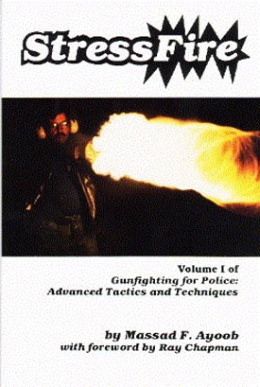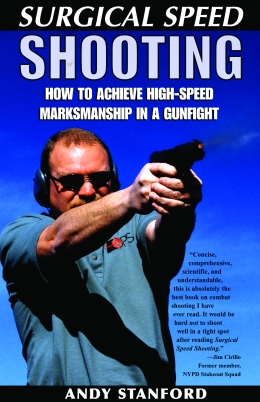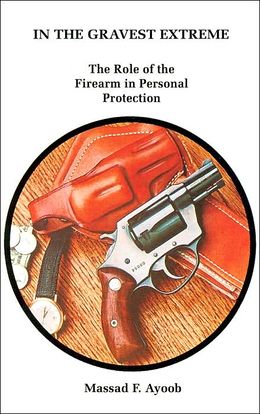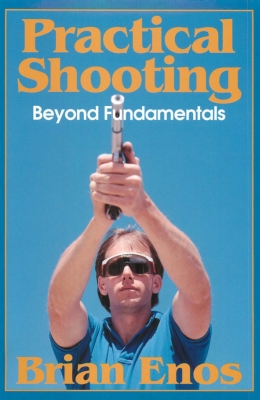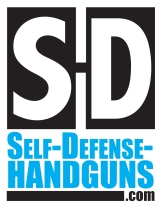Stressfire, Vol. 1 (Gunfighting for Police: Advanced Tactics and Techniques)
Buy Now on Amazon.com
For the hardcore, dedicated gun carrier, Massad Ayoob has writen StressFire, subtitled Volume I of Gunfighting for Police: Advanced Tactics and Techniques. The first thing to strike you about this book is the absolutely awesome cover photo capturing the vortex-like fireball as Ayoob triggers one round of Federal .357 Magnum 125-grain jacketed hollowpoint out of a 4-inch barreled Smith & Wesson Model 13 revolver. Muzzle flash provides the only illumination for the photo. This shot was taken, obviously, before the era of flash-retardant powders greatly reduced the super-flamethrower effect of many .357 Magnum loads, including the Federal 125-grainers.
StressFire is a book on gunfighting. In it Ayoob puts forth the techniques he believes work best, based on having debriefed hundreds of gunfight survivors. It’s good stuff. Ayoob looks into this controversial topic with rare insight. He was one of the first well-known instructors, for instance, to condemn the Weaver Stance as a combat technique, recommending instead a modified isosceles. Read this book, see if you can argue with his logic.
Massad Ayoob is a wonderfully articulate writer, with extremely strong opinions. Like his fellow gunwriter and instructor Jeff Cooper, he’s the sort of larger-than-life personality that attracts both devoted followers and sworn enemies. Just to make it clear where I come down on the topic, I’ve trained with Mas Ayoob, I’ve read his articles and books for 20-plus years, I like the guy. But whether you love him or hate him, there’s one fact that’s undeniable: no one can honestly say he’s done more to provide good, solid information on the use of the defensive handgun to the average citizen than Massad Ayoob.
Do I agree with everything in this book? No. Every highly trained gunperson is going to have their own repertoire of preferred techniques, some of which might differ from what Ayoob puts forth in StressFire. And that’s fine. I will say, however, that in order to have an informed opinion on the topic of gunfight survival, StressFire is one of the books you simply must have read.
Surgical Speed Shooting: How to Achieve High-Speed Marksmanship in a Gunfight
Buy Now on Amazon.com
Andy Stanford’s name is well-known to people heavily involved in the firearms training community. His main claim to fame is as the winner of the fourth National Tactical Invitationals. A Master class IDPA shooter, he also runs a training school called Options for Personal Security (OPS).
In this book Stanford takes high-speed gun handling and marksmanship techniques that saw their genesis in IPSC (the International Practical Shooting Confederation, simulated gunfighting competition) and uses them as the basis for his recommended self-defense shooting methods. Kind of the best of both worlds there. High-speed, precision gun handling is the serious IPSC shooter’s forte. It only makes sense, if you want the best techniques available to shoot fast and straight in a real-world emergency, you apply methods developed, and used, by the best practical pistol shooters.
Stanford’s recommended techniques are built around the Modern Isosceles stance. In a clever play on Jeff Cooper’s Weaver-centric “Modern Technique of the Pistol,” Stanford refers to the Modern Isosceles as the “Post-Modern Technique of the Pistol.” Also recommended are the straight-thumbs method of gripping a handgun. Stanford understands things about the subtleties of this grip technique I’ve never seen discussed in a book before. I only knew them myself by piecing together things I’ve learned during years of reading on the topic, and personal instruction from some of the best firearms trainers on Earth.
Particularly impressive is Stanford’s instruction on trigger control. The method he recommends, of taking up the slack, prepping the trigger, firing the shot, hitting the trigger reset and re-prepping the trigger while the gun is still in recoil, is one of two techniques used by advanced-level shooters (the other being “trigger slapping”). In my experience, trigger control is the area of marksmanship in which the serious student is least likely to find competent instruction…because most firearms instructors don’t really understand the concept, and can’t execute it themselves. That’s not the case with Andy Stanford.
Because this book is concerned with self-defense shooting, in places the pure efficiency of a technique has been sacrificed for perceived tactical superiority. For instance, most decent IPSC shooters fire from an almost upright position with only a bit of forward lean; Stanford by contrast prefers a much more forwardly aggressive body posture in case you have to resist being bowled over by a charging attacker. Also, when describing his recommended draw stroke, Stanford elects to flag the support hand high and flat against the chest during the first part of the draw, staging it to execute contact distance hand-to-hand combat techniques, if necessary. From the standpoint of pure speed, of course, it’s faster to hold the hand slightly away from the body, ready to accept the gun. So there has been some tinkering with the basic techniques to make them more “tactical.”
Surgical Speed Shooting is touted in Paladin Press literature as providing “truly advanced techniques for grip, stance, aiming, and follow-through.” And that’s true, if by “truly advanced” you mean “based on the best techniques out there.” On the other hand, there’s little here that the best IPSC shooters in the world didn’t figure out 20-plus years ago. What makes this book valuable – and make no mistake, I consider this a very valuable book – is that, more so than anything else I’ve ever read, it gathers those best techniques between the covers of one slim volume, and presents them in a fashion the average shooter can understand.
Well, until I wrote my own book on the topic, of course.
Great Pistol Shooting Made Simple
In the Gravest Extreme: The Role of the Firearm in Personal Protection
Buy Now on Amazon.com
In the Gravest Extreme is the most popular book Massad Ayoob has ever written. Copyright 1980, within 18 months of initial publication it was into its fifth printing – nearly unheard of for a privately published book with almost no advertising. It’s been widely endorsed by police officers, lawyers, even judges. What made the book special, then and now, is that while there’ve always been plenty of how-to books for beginning shooters, there’d never before (or since) been one that so well addressed the legal, moral, and practical considerations of integrating a defensive handgun into your life.
Let’s examine just one chapter to see why this book is so good for novice gun people. Chapter 1, Self-Defense and Lethal Force addresses the important question, “When can I pull the trigger?” The central premise of this chapter, indeed the book as a whole, is that which inspired the book’s title: you may only use a firearm in self-defense when in the gravest extreme of immediate, unavoidable, deadly danger.
If I could level one criticism at In the Gravest Extreme, it’s that the chapter on Women and Guns is extremely dated, and more than a little sexist. Ayoob’s advice to women: choose a .22 for its light recoil, and “If you do work up to a .38, lean way forward into the recoil, unless you’re a big girl.” Oh, please. It’s worth noting, these days Ayoob recommends things like 1911 .45 autos for the well-trained female shooter. I just wish this book reflected his awakened understanding of women’s capabilities.
Many firearms instructors make reading In the Gravest Extreme a prerequisite to graduate from their course, or even factor providing the student a copy into the class fee. Anyone who contemplates owning or carrying a gun should have this book, and reread it frequently. In the Gravest Extreme demystifies the process of owning a gun, and replaces it with solid knowledge and hardheaded common sense. In the world of the defensive handgun this book occupies a unique place; it is THE definitive, indispensable beginner’s text. If you only ever buy one gun book, it should be this one.
Practical Shooting : Beyond Fundamentals
Buy Now on Amazon.com
The name Brian Enos is familiar to anyone with even a cursory knowledge of the action shooting sports. In the late 1970s and early ’80s, Enos and his good friend Rob Leatham revolutionized competitive shooting by developing techniques allowing high speed pistol control – and a level of performance – previously impossible. They did this by questioning everything, throwing out many of the sacred cows like the Weaver Stance espoused by the experts of the day, and embracing anything – no matter how unconventional – that worked. The techniques they developed (for a few years, until the other guys could adopt the same methods to catch up) didn’t just put Leatham and Enos ahead of the rest of the best in the world – they were in an entirely different CLASS.
Beyond Fundamentals has been called by those who’ve read it, “Zen and the Art of Pistol Shooting.” It’s also been called, “A book written by an IPSC Grand Master that you have to be an IPSC Grand Master to understand.” There’s a certain amount of truth to that. Most books on handgun marksmanship tell you that truly high-level shooting really has very little to do with equipment and technique, it’s 95 percent mental…then spend 95 percent of the rest of the book talking about equipment and technique! Enos tells you shooting is 95 percent mental, then spends 95 percent of the rest of the book talking about mental states of consciousness.
The reason no one had ever written a book like this before, and why some people find it impenetrable even today, is because it’s just damn hard to describe a mental state of consciousness so that someone who’s never experienced it can understand what you’re talking about. This is definitely a book that benefits frequent re-reading as your skill level improves. The first time I read Beyond Fundamentals I was lost throughout most of it. “What the hell is this guy talking about?” I thought. A few years later, when I read it again, I found it much more comprehensible because, in the intervening time frame, my skill level had improved to the point I could just barely brush the edges of a lot of the stuff Enos describes. Then I found the book going by fairly fast, and absolutely fascinating reading. “This is so cool. I’m already 40 pages into this thing and he hasn’t said anything I don’t understand yet.”
Enos takes ideas from sources as far-flung as bull’s-eye shooting, golf, martial arts, even motorcycle racing, and synthesizes them. At times this book seems more a tome on Buddhist philosophy or some Eastern fighting system than a shooting manual. Not to worry though, for those who want instruction on technique it’s here in abundance: in-depth discussion on the biomechanics of shooting, written by one of the best shooters in the world. But while reading that may certainly improve your performance, if you really want to excel it’s the “hard to understand” portions of the book – the discussions of mental states – that will over the long term prove the most invaluable, and eventually take you the farthest.
Enos does not discuss self-defense tactics in his book – it’s about pure shooting skill. Some folks of the “martial artist” persuasion might opine, “Well, I don’t have anything to learn from a guy like Enos. I’m a combat shooter and he’s a gamesman.” Frankly, in my opinion, any defensively oriented handgunner who honestly believes he has nothing to learn from an IPSC Grand Master is a freakin’ idiot. IPSC Grand Masters are the GODS of fast and accurate handgunning. No one knows more about how to fire a handgun fast and well than these guys – and that’s definitely a skill that could come in handy in a real-life emergency. This is a classic text that should be part of every serious handgunner’s library.
